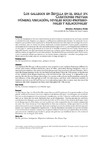Identificador persistente para citar o vincular este elemento:
https://accedacris.ulpgc.es/handle/10553/58963
| Campo DC | Valor | idioma |
|---|---|---|
| dc.contributor.author | Ronquillo Rubio, Manuela | en_US |
| dc.date.accessioned | 2019-12-17T14:48:03Z | - |
| dc.date.available | 2019-12-17T14:48:03Z | - |
| dc.date.issued | 2007 | en_US |
| dc.identifier.issn | 1131-8155 | en_US |
| dc.identifier.other | Dialnet | |
| dc.identifier.uri | https://accedacris.ulpgc.es/handle/10553/58963 | - |
| dc.description.abstract | La Sevilla bajo medieval fue una ciudad bastante receptiva respecto a la presencia de una buena cantidad y variedad de recién llegados con orígenes y calificaciones profesionales diversas. En particular los extranjeros, que ayudaron tanto a potenciar su desarrollo mercantil, han sido objeto de investigación en muchas ocasiones, pero no fueron los únicos implicados en dicho desarrollo. Ciertos grupos castellanos, concretamente los vascos que han sido analizados desde el siglo XIII al XV, y los burgaleses del último tercio del siglo XV, aparecen igualmente en la base de la vitalidad comercial de esta ciudad. Puesto que es imposible hacerse una idea aproximada del papel que cualquier grupo foráneo puede desplegar en los ámbitos urbanos de significativa actividad mercantil, finalmente habrá que analizarlos todos. Por tal razón, y por el sustancial número que aparece en las fuentes, hemos comenzado a estudiar a los gallegos residentes tanto en la ciudad como en su entorno rural a lo largo del siglo XV. | en_US |
| dc.description.abstract | Late medieval Seville was, without question, very receptive to new residents from many different locations and of many different profession, many of whon, particularly foreing inmigrants, were y’s mercantile development. But certain Castilian groups were also involved in this development. Previously the Basque presence in the city has been analyzed from 13th to the 15th century, as has the roleof new residents from Burgos beginning in the last third of the 15th century. It is impossible to appreciate the role that any foreign group plays in a society withoun knowing the population and political influence of the other groups as well. For this reason, and there were substantial numbers of Galicians not only in seville itself but aso in te surrounding region, than we must study the role of the Galicians who were integrated into these zones throughout the 15th century. | en_US |
| dc.description.abstract | Au Bas Moyen Âge, la ville de Séville a assez bien accueilli la présence d’un grand nombre et d’unegrande variété de nouveaux venus aux origines et professions diverses. Les étrangers, qui contribuèrent tant au développement de sa puissance commerciale, ont fait l’objet de nombreuses recherches, mais ce ne furent pas les seuls impliqués dans ce développement. Certains groupes de castillans, concrètement les Basques, qui ont été étudiés du XIIIe au XVe siècle, et les citoyens de Burgos, à partir du dernier tiers du XVe siècle, ont joué un rôle tout à fait comparable dans la vitalité commerciale de cette ville. Etant donné qu’il est impossible de faire une estimation, même aproximative, du rôle particulier que peut jouer tout groupe forain peut déployer au sein de communautés urbaines que présentant une vigueur commerciale significative, il faudra finalement nécessaire de tous les analyser. C’est la raison pour laquelle, compte tenu du grand nombre d’entre eux qui apparaît dans les sources, que nous avons commencé par étudier le groupe des galiciens qui résidèrent dans la ville et dans le hinterland, tout au long du XVe siècle. | en_US |
| dc.language | spa | en_US |
| dc.relation.ispartof | Medievalismo | en_US |
| dc.source | Medievalismo: Boletín de la Sociedad Española de Estudios Medievales [ISSN 1131-8155] (17), p. 151-186 | en_US |
| dc.subject | 55 Historia | en_US |
| dc.subject.other | Sevilla bajomedieval | en_US |
| dc.subject.other | Inmigraciones | en_US |
| dc.subject.other | Gallegos | en_US |
| dc.subject.other | Galicia | en_US |
| dc.subject.other | Seville | en_US |
| dc.subject.other | Galicians inmigrants | en_US |
| dc.subject.other | Late Middle Ages | en_US |
| dc.subject.other | Séville | en_US |
| dc.subject.other | Galiciens | en_US |
| dc.subject.other | Immigrants | en_US |
| dc.subject.other | Migrations intérieures | en_US |
| dc.subject.other | Bas Moyen Âge | en_US |
| dc.title | Los gallegos en Sevilla en el siglo XV | en_US |
| dc.type | info:eu-repo/semantics/article | en_US |
| dc.type | Article | en_US |
| dc.identifier.url | http://dialnet.unirioja.es/servlet/articulo?codigo=3419588 | - |
| dc.description.lastpage | 186 | - |
| dc.identifier.issue | 17 | - |
| dc.description.firstpage | 151 | - |
| dc.investigacion | Ciencias Sociales y Jurídicas | en_US |
| dc.type2 | Artículo | en_US |
| dc.contributor.authordialnetid | 116003 | - |
| dc.identifier.dialnet | 3419588ARTREV | - |
| dc.identifier.ulpgc | Sí | es |
| dc.description.esci | ESCI | |
| dc.description.erihplus | ERIH PLUS | |
| item.grantfulltext | open | - |
| item.fulltext | Con texto completo | - |
| crisitem.author.dept | GIR G9-Historia, economía y sociedad | - |
| crisitem.author.orcid | 0000-0001-7787-1582 | - |
| crisitem.author.parentorg | Departamento de Ciencias Históricas | - |
| crisitem.author.fullName | Ronquillo Rubio, Manuela | - |
| Colección: | Artículos | |
Visitas
104
actualizado el 31-ago-2024
Descargas
38
actualizado el 31-ago-2024
Google ScholarTM
Verifica
Comparte
Exporta metadatos
Los elementos en ULPGC accedaCRIS están protegidos por derechos de autor con todos los derechos reservados, a menos que se indique lo contrario.
